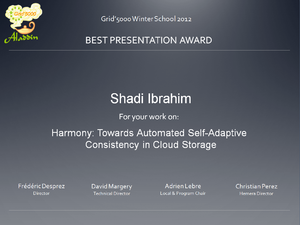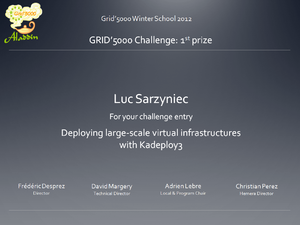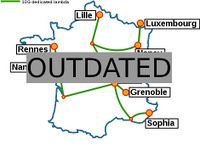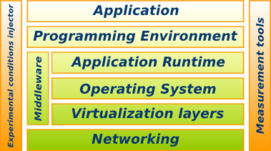Grid5000:Home
|
|
Latest updates from Grid'5000 users
- Experiments
{{#experiments:3|||**}}
- Publications
Five random publications that benefited from Grid'5000 (at least 2777 overall):
- Jean-Baptiste Decourcelle, Tu Dinh Ngoc, Boris Teabe, Daniel Hagimont. Fast VM Replication on Heterogeneous Hypervisors for Robust Fault Tolerance. Middleware '23: 24th International Middleware Conference, Dec 2023, Bologna Italy, France. 14 p., 10.1145/3590140.3592849. hal-04095419 view on HAL pdf
- Prerak Srivastava, Antoine Deleforge, Archontis Politis, Emmanuel Vincent. How to (Virtually) Train Your Speaker Localizer. INTERSPEECH 2023, Aug 2023, Dublin, Ireland. hal-03855912v3 view on HAL pdf
- Dorian Goepp, Samuel Brun, Quentin Guilloteau, Olivier Richard. Un prototype de cache de métadonnées pour le passage à l'échelle de NixOS-Compose. COMPAS 2024 - Conférence francophone d'informatique en Parallélisme, Architecture et Système, Jul 2024, Nantes, France. pp.1-8. hal-04632952 view on HAL pdf
- Lucian Trestioreanu, Flaviene Scheidt, Wazen M. Shbair, Jerome Francois, Damien Magoni, et al.. To Squelch or not to Squelch: Enabling Improved Message Dissemination on the XRP Ledger. 37th IEEE/IFIP Network Operations and Management Symposium (NOMS 2024), May 2024, Séoul, South Korea. hal-04621124 view on HAL pdf
- Anna Kravchenko, Sjoerd Jacob De Vries, Malika Smaïl-Tabbone, Isaure Chauvot de Beauchêne. HIPPO: HIstogram-based Pseudo-POtential for scoring protein-ssRNA fragment-based docking poses. BMC Bioinformatics, 2024, 10.1186/s12859-024-05733-6. hal-04234486v2 view on HAL pdf
Latest news
Grid'5000 users win second prize at CCGRID 2013's SCALE challenge
Snooze based entry running on Grid'5000 entry wins 2nd prize at CCGrid 2013 SCALE challenge: well done Matthieu and Anne-Cécile for defending the entry titled Scalability of the Snooze Autonomic Cloud Management System by Eugen Feller, Christine Morin, Matthieu Simonin, Anne-Cécile Orgerie, and Yvon Jégou.
Grid'5000 users finalists of the SCALE'2013 challenge
Two submissions (out of five) from Grid'5000 users took part in the final of the international SCALE'2013 challenge (held with CCGrid'2013):
- D. Balouek, A. Lèbre, F. Quesnel Flauncher and DVMS -- Deploying and Scheduling Thousands of Virtual Machines on Hundreds of Nodes Distributed Geographically
- Eugen Feller, Christine Morin, Matthieu Simonin, Anne-Cécile Orgerie, and Yvon Jégou -- Scalability of the Snooze Autonomic Cloud Management System.
The first proposition presents the deployment and scheduling of thousands of virtual machines, conducted with the Flauncher and DVMS frameworks, across the Grid'5000 testbed. The frameworks have been able to deploy and schedule up to 10000 VMs during the tests. This research has been conducted in the context of the INRIA Hemera initiative.
The second proposition presents the Snooze architecture and focus on the following aspects :
- System set up scalability and resources consumption,
- Self-healing capabilities.
The deployment of Snooze were distributed over several sites of the Grid'5000 testbed. The framework has been able to start 11000 of system services, recover thousands of failures and used to launch large hadoop/mapreduce experiments. This research has been conducted in the context of the INRIA Snooze ADT.
Grid'5000 tutorial during ComPAS'2013
The ComPAS'2013 conference (replacing RenPar, SympA and CFSE), to be held in Grenoble between January 15th and 18th, will feature a Grid'5000 tutorial.
Grid'5000 Winter School 2012 award winners announced
The Grid'5000 winter school took place between Decembre 3rd, 2012 and December 6th, 2012 in Nantes. This highly successful edition brought together 70 registered participants for 4 days of tutorials and talks focusing on best-practices, results and links to other tools for experiment-driven research.
Two awards were given during the event :
|
Best presentation award to Shadi Ibrahim |
1st prize for the Grid'5000 challenge 2012 to Luc Sarzyniec |
Grid'5000 at a glance
- Grid'5000 is a scientific instrument for the study of large scale parallel and distributed systems. It aims at providing a highly reconfigurable, controlable and monitorable experimental platform to its users. The initial aim (circa 2003) was to reach 5000 processors in the platform. It has been reframed at 5000 cores, and was reached during winter 2008-2009.
- The infrastructure of Grid'5000 is geographically distributed on different sites hosting the instrument, initially 9 sites in France (10 since 2011). Porto Alegre, Brazil is now officially becoming the first site abroad.
Sites:
- Grid'5000 is a research effort developing a large scale nation wide infrastructure for large scale parallel and distributed computing research.
- 19 laboratories are involved in France with the objective of providing the community a testbed allowing experiments in all the software layers between the network protocols up to the applications.
The current plans are to extend from the 9 initial sites each with 100 to a thousand PCs, connected by the RENATER Education and Research Network to a bigger platform including a few sites outside France not necessarily connected through a dedicated network connection. Sites in Brazil and Luxembourg should join shortly, and Reims has now joined.
All sites in France are connected to RENATER with a 10Gb/s link, except Reims, for the time linked through a 1Gb/s
This high collaborative research effort is funded by INRIA, CNRS, the Universities of all sites and some regional councils.
ALADDIN-G5K : ensuring the development of Grid'5000
For the 2008-2012 period, Engineers ensuring the development and day to day support of the infrastructure are mostly provided by INRIA, under the ADT ALADDIN-G5K initiative.
HEMERA: Demonstrating ambitious up-scaling techniques on Grid'5000
Héméra is an INRIA Large Wingspan project, started in 2010, that aims at demonstrating ambitious up-scaling techniques for large scale distributed computing by carrying out several dimensioning experiments on the Grid’5000 infrastructure, at animating the scientific community around Grid’5000 and at enlarging the Grid’5000 community by helping newcomers to make use of Grid’5000.
Initial Rationale
The foundations of Grid'5000 have emerged from a thorough analysis and numerous discussions about methodologies used for scientific research in the Grid domain. A report presents the rationale for Grid'5000.
In addition to theory, simulators and emulators, there is a strong need for large scale testbeds where real life experimental conditions hold. The size of Grid'5000, in terms of number of sites and number of processors per site, was established according to the scale of the experiments and the number of researchers involved in the project.
Current funding
As from June 2008, INRIA is the main contributor to Grid'5000 funding.
INRIA |
CNRS |
UniversitiesUniversity Joseph Fourier, Grenoble |
Regional councilsAquitaine |






